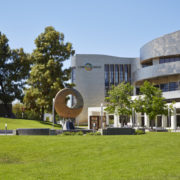A model for families, public services and local economy
Twenty miles (or roughly thirty minutes of travel) to southeast of Los Angeles is Cerritos — an upper-middle class city which is family-oriented and flaunts a strong local economy.
Formerly an agricultural community called Dairy Valley, Cerritos is now a modern hub of commercial and retail centers, including Cerritos Auto Square — the largest cluster of automobile dealerships in the world.
In 2013, the Cerritos Auto Square sold 52,300 cars. Though the 2006 record of 54,000 cars has yet to be surpassed, approximately 1,000 cars are being sold per week just five months into 2014.
Another landmark is the Los Cerritos Center — a 1.3 million square-foot shopping mall that is the largest revenue stream for the city, generating about $2.7 million in sales taxes annually.
“We have three projects under construction valued at $150 million. We just finished the $60 million project at the mall – we added a new Nordstroms at 135,000 square feet and more retail space. Now we’re doing phase five of the project…and we have more projects on the queue,” City Manager Art Gallucci said.
With a median income of $95,797 and data from the California State Board of Equalization (which found residents to be the second largest retail spenders in the state — at an average of $36,544 per resident, just trailing behind Beverly Hills), Cerritos has demonstrated its resilience despite a tough economic climate.
Due to the state’s elimination of redevelopment, the City Council has to find ways to raise money for its annual $90-million operating budget, through economic and housing developments.
“We’ve turned a corner on the recession. Our city leaders and staff are moving forthrightly in order to ensure the fiscal strength and viability of our community. We want to continue to provide the services and the programs that our residents have come to expect,” Cerritos Mayor Mark Pulido said.
During the fourth quarter of 2013, the average median home sales price was $605,867 — an indication that the prices of single-family residential homes have increased.
Near the Cerritos Towne Center (on the corner of Artesia Boulevard and Bloomfield Avenue) is a $74.3-million apartment project called the Aria. The 198-unit upscale complex is slated for completion by 2015 and aims to attract young professionals and small-sized families.
Another two-and-a-half acre residential project nearby is also expected to be built soon as well.
Even with the spur of businesses and expansion programs cropping up in Cerritos, the City Council still asserts that the residents are the utmost priority.
Though there are no specific campaigns to lure in new residents (especially immigrants) to the city, the attraction of services, a high-performing school district and a low crime rate speak for themselves.
The city maintains over twenty parks and recreational centers, such as Liberty and Heritage Parks and the Olympic Swim and Fitness Center, which contribute to the overall healthy living planning.
The Cerritos Library (which is open seven days a week) has received numerous awards, including Best Public Library in the “Best of LA” issue of Los Angeles Magazine and the Award of Excellence from the American Library Association.
Cerritos is covered under the ABC Unified School District — one of the high performing districts in the state and country.
One of the schools, Whitney High School, has been nationally ranked as the 22nd best high school and second best in the state of California by US News & World Report.
Cerritos High School has also been ranked 56th in the state, when it comes to above average college readiness.
“Immigrants have figured out that Cerritos is a very welcoming community. If you look at our demographics, you can see a very large Asian-American population,” City and Theater Marketing Manager Annie Hylton added.
Over 60 percent of the reported 49,041 residents are of Asian descent: Chinese (15.1 percent); Koreans (14.8 percent); and Filipinos (14.6 percent). They also own and operate a majority of the businesses in the city.
“[Cerritos] didn’t happen overnight. It took a lot of planning and foresight…in order to attract the mix of businesses so that our local economy is strong, so that people from all over the world when they come to the United States and decide where to live, they want to come to a community that is strong, safe [and] provides good neighborhoods to raise their children,” Pulido said.







